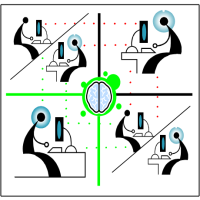Cognitive Radio for ‘Smart’ Building Environments
Cognitive Radio (CR) is likely to operate best in indoor or short-range scenarios, where buildings can be used to provide a variable degree of shielding, enhancing frequency reuse. The purpose of this project is to explore an exciting new dimension in the development of CR, namely the benefits it would bring to users and systems operating in ‘smart’ buildings environments.
"Smart" buildings, capable of enhancing the occupant’s experience, are being proposed by a number of designers. Of interest to CR is if the building structure could intelligently interact with the cognitive devices and change its radio characteristics to better support the plethora of wireless communications services that will operate in such buildings of the future. Using information obtained indirectly from the signals themselves, walls and other structures would adjust their reflection and transmission characteristics on a frequency selective basis. For example in some situations it may be necessary to shield transmissions from one room to another for security purposes, or alternatively to prevent interference, enabling increased system capacity. In other situations walls may need to be transparent to allow inter-room communication, or allow communications to outside networks. Dynamic changes in the building structure could even be used to assist in the wireless routing of packets. In practice a wall may be required to allow both transmission and reflection simultaneously at different frequencies.
A mixture of simulation and analysis will be used to assess performance, and it is expected that game theory and Markov analysis will be particularly important analytical tools. This work will integrate closely with other activities within the Group.
Key objectives
- To understand how CR based systems can best exploit ‘smart’ building environments.
- To determine desirable dynamic changes in building structures that will improve CR performance.
- To develop CR based algorithms that exploit ‘smart’ environments.
- To understand how directional antennas can be used to improve relaying performance.
Outputs
- CR based schemes that are intended for smart buildings
- Possible idealised changes to wireless properties of a building structure.
- Simulations and analysis showing relative performance of the schemes with and without dynamic building changes.
- Contributions to conference and journal papers.

Members
- Elizar
- David Grace
- Paul Mitchell
Dates
- Start: November 2007
Research
